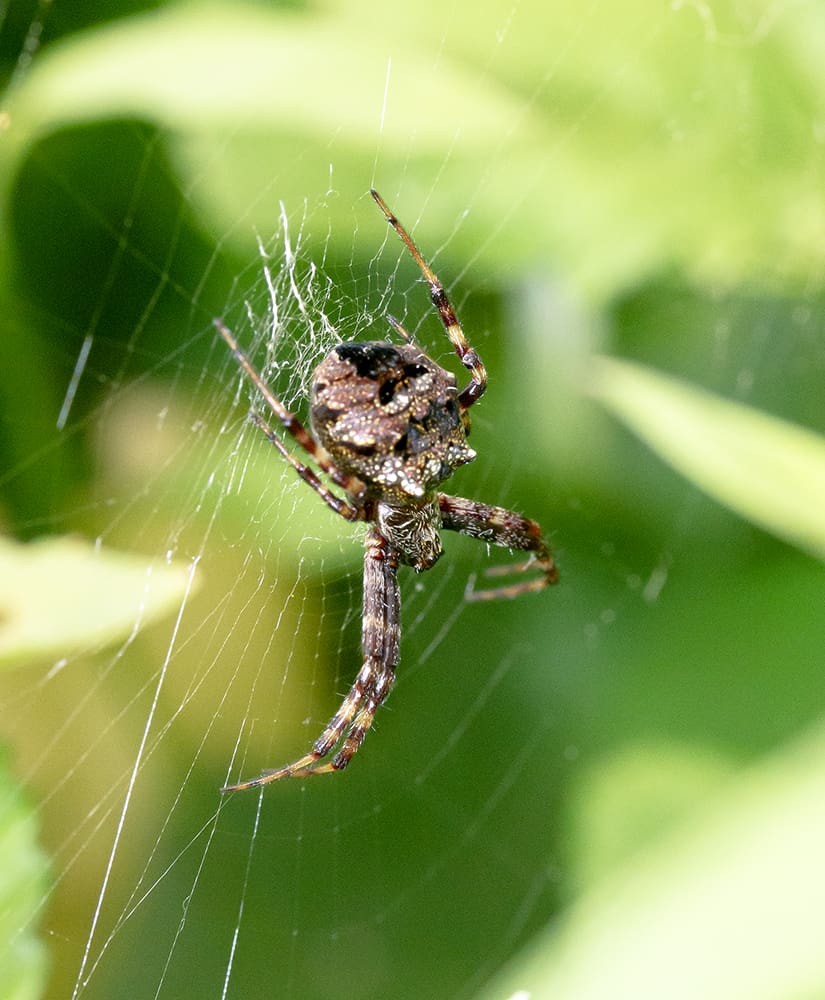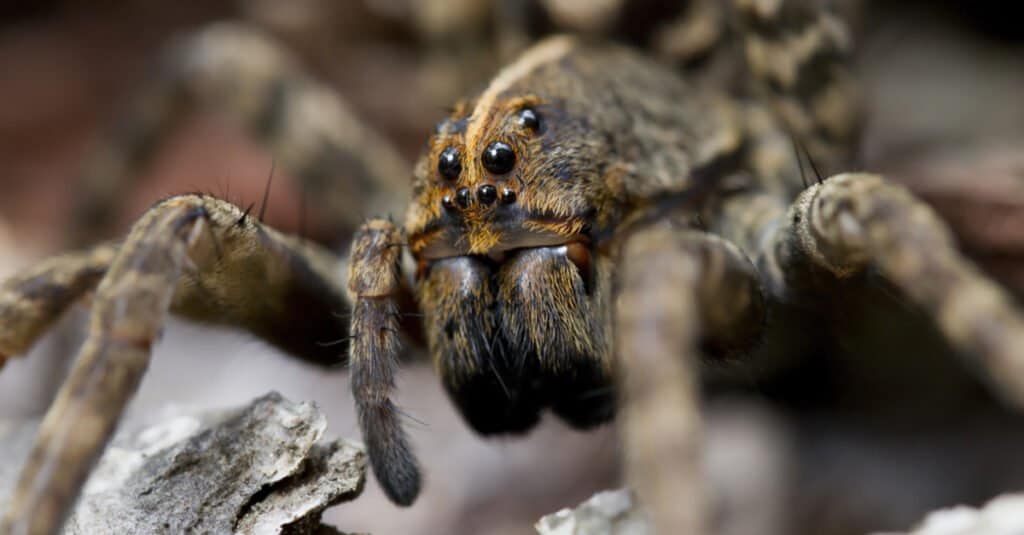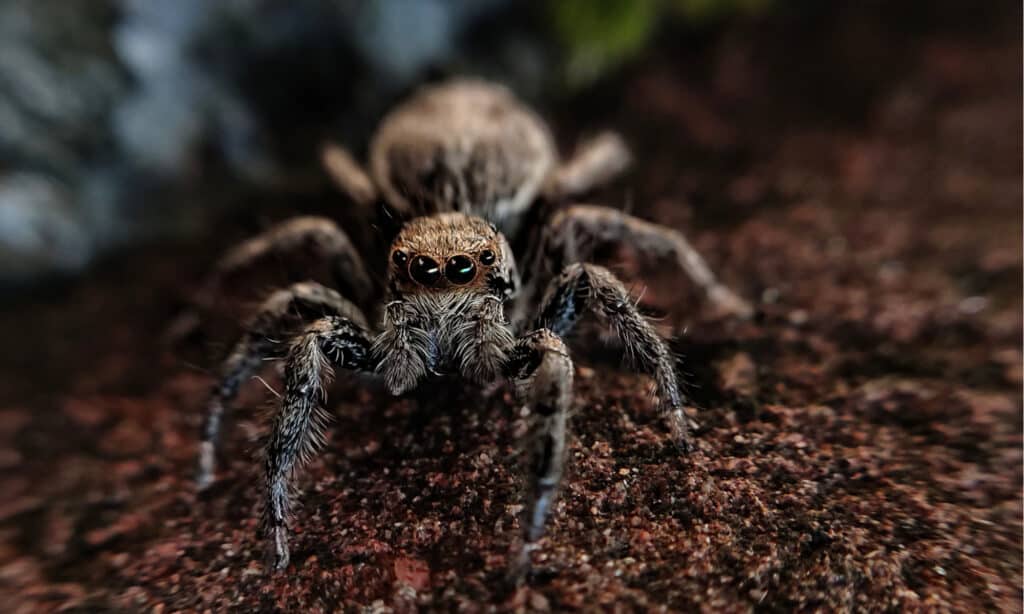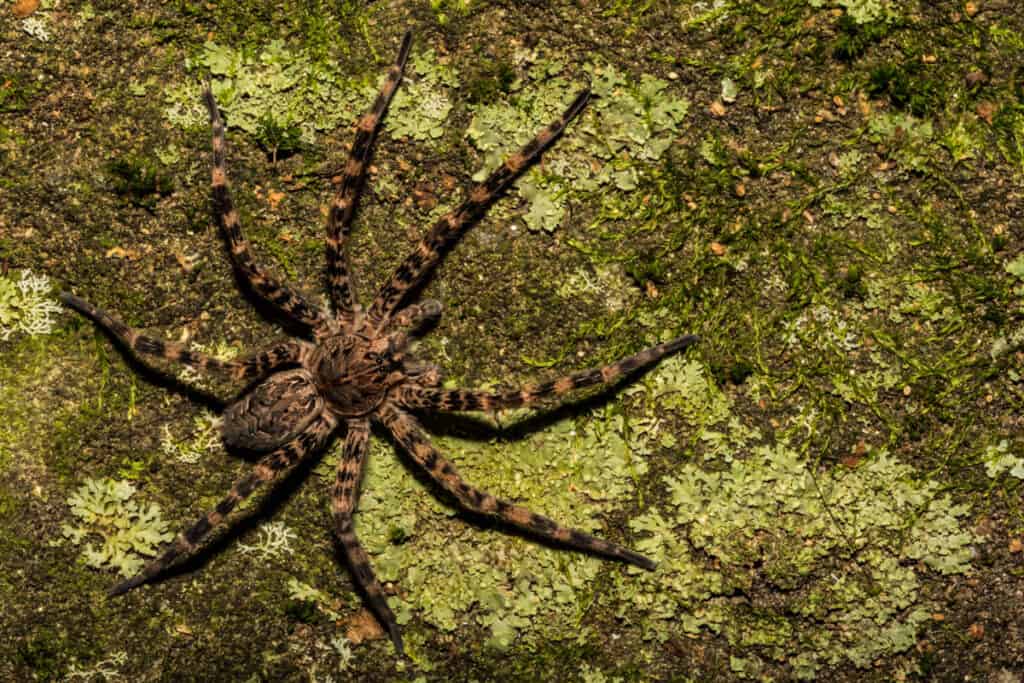
Amidst the sprawling prairies and picturesque hills of Oklahoma, many creatures inhabit the state, including various brown spiders. These eight-legged arachnids may not be the most popular among residents, but they play a vital role in the state’s ecosystem. With their unique behaviors and adaptations, brown spiders have fascinated scientists for years.
Get ready to discover many exciting facets of brown spiders and gain a new appreciation for these often-misunderstood creatures.
1. Heptagonal Orbweaver (Gea Heptagon)

Heptagonal orbweavers are known for their unique X-shaped leg position while hanging the head-down.
©WanderingMogwai / Creative Commons – License
The heptagonal orbweaver has now become a familiar sight in Oklahoma. This species was introduced to several states in the United States.
This spider is small with a brown and yellow body. It is known for its unique X-shaped leg position while hanging its head-down. Female spiders have a large, flattened, grayish-tan head. Their abdomen is brown with gold and white markings, with noticeable angular bumps on the back. The legs are yellow brown with dark bands. Males are lighter in color and have a slender build with smaller abdomens. The spider’s body and legs have sparse hairs and small spines. The distinctive heptagonal shape of the abdomen can be observed from above.
It is approximately a quarter inch in size, excluding the length of its legs. And both females and males are around the same size.
The heptagonal orbweaver’s webs are built close to the ground and may feature a distinctive zigzag pattern in the center. These spiders drop down to the ground immediately in response to any slight disturbance.
They are predominantly outdoor spiders and typically inhabit regions surrounding fences, shrubs, and grassy areas.
Heptagonal orbweavers, like most orbweaver spiders, capture small flying insects by trapping them in the sticky strands of their webs. Common prey for these spiders includes small flies, tiny moths, and leafhoppers.
Although heptagonal orbweavers may carry mild venom, it is generally not harmful to humans or larger animals.
Fun Facts
- They have limited eyesight and rely on their webs to capture prey.
- The adult spiders do not survive the first freezes, and only the eggs overwinter.
- The egg sacs are a source of winter food for many bird species and other predators as well.
2. Carolina Wolf Spider (Hogna carolinensis)

These spiders possess light-reflecting eyes, making them more easily recognizable during nighttime encounters.
©Will E. Davis/Shutterstock.com
In Oklahoma, it is not uncommon to spot the Carolina wolf spider. It happens to be the largest wolf spider species in North America.
The Carolina wolf spider has a predominantly light brown coloration with distinctive dark brown patterning. Their undersides are typically darker black. Male spiders may exhibit orange coloration on their abdomen. These spiders also possess light-reflecting eyes, making them more easily recognizable during nighttime encounters. Females have a body length of approximately 1 inch, while males tend to be slightly smaller.
The Carolina wolf spider has a unique hunting behavior, as it does not rely on web-spinning to catch prey. Instead, these spiders ambush their prey from burrows.
They create burrows in open areas of various habitats, including fields, forests, and meadows. During the day, they are likely to take shelter under rocks for protection.
Carolina wolf spiders typically feed on small invertebrates and insects. They inhabit areas around houses and may prey on pests like cockroaches if they are available.
It is possible to be allergic to the venom of a wolf spider. However, they generally do not pose a threat to humans. Don’t let their massive size fool you! Wolf spiders are not poisonous, and their venom is not considered dangerous.
Fun Facts
- A group of predatory ants once consumed a Carolina wolf spider inside its burrow.
- The Carolina wolf spider relies on quick speed and excellent eyesight to capture prey.
- Females have a lifespan of up to three years, while males typically only live up to one year.
3. Tan Jumping Spider (Platycryptus undatus)

Their most striking feature is their large front-facing eyes, which give them a mammal-like appearance.
©SwastikEs/Shutterstock.com
Due to their active and bold nature, it is not uncommon to spot tan jumping spiders in Oklahoma.
Tan jumping spiders are small and covered in fur. Their most striking feature is their large front-facing eyes, which give them a mammal-like appearance. They have eight eyes in total, providing almost 360-degree vision.
Female tan jumping spiders measure 0.39-0.51 inches, and males are slightly smaller, measuring between 0.33-0.37 inches.
Tan jumping spiders exhibit remarkable courtship behaviors that include complex body movements and sound production. During the courtship dance, males utilize their forelegs to create a series of signals and wave patterns. These are accompanied by rhythmic drumming on the ground. These displays are essential in conveying to the female that the male is interested in mating.
These spiders have a tendency to cling onto vertical surfaces such as tree trunks, fence posts, and building walls. They are commonly spotted during the fall season, as they tend to venture indoors and crawl on walls within households.
Tan jumping spiders are visual hunters. Their diet consists of various small creatures such as flies, moths, aphids, and even other spiders. Their exceptional eyesight allows them to easily track and capture their prey.
These spiders are capable of biting. Their bites are not venomous and are generally considered harmless. As such, they are not regarded as a dangerous species.
Fun Facts
- Tan jumping spiders move in an erratic, jerky manner.
- Their bodies are flattened in shape.
- During the winter months, jumping spiders hide inside small silk cocoons to survive the cold.
4. Dark Fishing Spider (Dolomedes tenebrosus)

The dark fishing spider has a mottled appearance, consisting of black and brown hues with minimal white markings.
©iStock.com/JasonOndreicka
While not typically associated with water, the dark fishing spider’s considerable size in Oklahoma can be alarming to some.
The dark fishing spider has a mottled appearance, consisting of black and brown hues with minimal white markings. Distinct W-shaped patterns appear on the upper surface of the abdomen. Its legs are often straight and have banding of brown and darker shades.
Females of this species can range from ½ to 1 inch in length (not including the legs), with a leg span that can reach up to 3 inches. Meanwhile, males typically measure between ¼ and ½ inch in length.
Dark fishing spiders possess remarkable hunting abilities, allowing them to run swiftly over water while chasing prey such as small fish and aquatic insects. In situations of perceived danger, these spiders dive below the water’s surface as a form of protection.
In contrast to other fishing spider species, the dark fishing spider does not exclusively live near water sources. Although they can commonly inhabit areas near permanent water, such as shrubs, vegetation, and rocks, they also live in drier wooded regions.
The dark fishing spider’s diet primarily consists of insects and other small arthropods. Similar to other running spider species, they capture their prey by pouncing on it and delivering a bite.
Dark fishing spiders have the capability to bite humans, although they generally prefer to escape when confronted by people. If a bite occurs, the resulting symptoms are usually comparable to a bee or wasp sting and not deemed serious.
Fun Facts
- Male dark fishing spiders can only mate once, as they spontaneously die during copulation.
- Dark fishing spiders are skillful hunters even at a young age.
- During the month of June, females lay egg sacs that contain 1,000 to 1,400 eggs.
5. Triangulate Cobweb Spider (Steatoda triangulosa)

This spider is named after the triangular pattern on its creamy-colored, round, bulbous abdomen, which has purplish-brown zigzag lines.
©Timelynx/Shutterstock.com
The triangulate cobweb spider, a small species of household spider, can often go unnoticed in Oklahoma due to its size.
The triangulate cobweb spider’s adult female can measure from 1/8 to 1/4 inch, while the males are typically smaller. This spider is named after the triangular pattern on its creamy-colored, round, bulbous abdomen, which has purplish-brown zigzag lines running from front to back. Additionally, they have brownish-orange cephalothoraxes and thin, yellowish legs with tiny hairs.
Similar to other cobweb spiders, the triangulate cobweb spider spins a disorderly web in dark corners and crevices of man-made structures such as buildings. The triangulate cobweb spider primarily resides on windows and in several dimly lit, dirty corners of buildings and other human-made structures.
These spiders have a varied diet, eating insects such as arthropods and ants, including fire ants. They also feed on other spiders.
They are not aggressive towards humans, and their venom is not life-threatening to people, possibly due to their small size. However, as with all spiders, avoid handling or provoking them.
Fun Facts
- The triangulate cobweb spider rebuilds all or most of its web on a daily basis.
- Despite its small size, the spider is capable of feeding on insects and arachnids larger than itself.
- People often mistake it for the brown widow spider due to similarities in appearance.
6. Texas Brown Tarantula (Aphonopelma hentzi)

With leg spans reaching over 4 inches, Texas brown tarantulas are quite large.
©texas brown tarantula/Shutterstock.com
The Texas brown tarantula, also known as the Oklahoma brown tarantula, is a species inhabiting Oklahoma and other southern states.
With leg spans reaching over 4 inches, Texas brown tarantulas are quite large. The darker legs contrast with the lighter brown cephalothorax and abdomen, which are located at the head and rear end, respectively. Light-colored hairs near the feet can give the legs a grayish-white appearance. When feeling threatened, these tarantulas will rub off their rusty-orange hairs.
Although generally not aggressive, the Texas brown tarantula will defend itself if it feels threatened. Its primary response, when spotted, is to run for cover. If the spider raises and stretches out its front legs in an attempt to appear larger, this is a clear signal to back away. When stressed, the spider’s likelihood of biting increases.
Typically, bites from this tarantula do not pose a significant threat to humans unless an allergic reaction occurs. However, due to the tarantula’s large fangs, a bite can cause a painful puncture wound that may lead to secondary infection if not treated properly.
Dry, rocky glades are their preferred habitat, where they reside in silk-lined burrows during the daytime. These burrows inhabit abandoned tunnels previously used by rodents and reptiles or in other natural crevices. Tarantulas tend to inhabit areas that humans infrequently visit.
They feed on a variety of creatures, including insects like roaches and crickets, as well as mice and small lizards. Despite their voracious appetite, tarantulas do not need to eat very often and can go several weeks without food.
However, when they do eat, they do so aggressively. Unlike many spiders, tarantulas do not spin webs to capture prey. Instead, they walk along the ground and grab any insects that cross their path.
Fun Facts
- Females have a lifespan of more than 30 years, whereas males typically live for about seven years.
- Keeping Texas brown tarantulas as pets can be a viable option for those interested in owning them.
- The primary prey of tarantula hawks is the Texas brown tarantula, among other tarantulas.
The photo featured at the top of this post is © Alan Tunnicliffe/Shutterstock.com
Thank you for reading! Have some feedback for us? Contact the AZ Animals editorial team.






